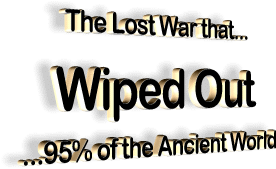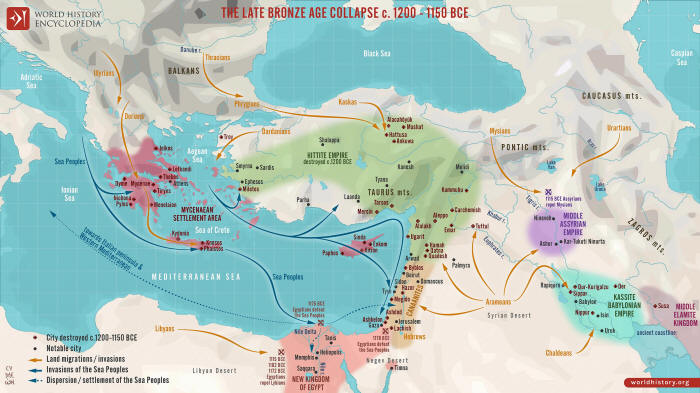|
Article also HERE
(Source: Simeon Netchev, World History Encyclopedia) was pushed into a dark age after a chain of disasters...
We imagine burning cities, riots, kings failing, and more. Such a perception, however, is questioned by the collapse of the late Bronze Age around 1177 BC.
The event was the first global crisis that significantly disrupted the political power in Greece and Mesopotamia, pushing the whole region into a centuries-long dark age...
Politically, alliances were weak, and trade was highly interdependent and centralized in palace economies.
Between 1500 and 1200 BC, the Eastern Mediterranean developed a complex system of interdependent empires that were as sophisticated as today's industrial societies.
Egypt under Ramses II was a symbol of affluence, grand constructions, and huge administrative control.
The Hittite Empire was a bureaucratic government of Anatolia.
In the Aegean, Mycenaean Greeks continued to maintain a system of fortified palace-states that organized trade and military expansion.
In Mesopotamia, the fertile rivers and long-distance commercial activities were organized admirably by the Babylonian and Assyrian powers. Archaeological evidence shows that the period portrayed signs of globalization.
The Uluburun wreck found on the Turkish coast contained Cypriot copper, Afghan tin, African ivory, Egyptian gold, and Baltic amber.
The existence of correspondence between kings, as in the Amarna Letters, indicates that kings in the region saw each other as equals, exchanging presents, wives, and diplomatic letters through a linguistic structure that depended on mutual understanding.
Policies were interdependent in terms of resources, technologies, and prestige.
A Chain of Disasters
The collapse of the Bronze Age did not arise from a single event.
According to modern historians,
Dendrochronological, palynological, and ice-core paleoclimatic data indicate a sudden climatic decline circa 1200 BC.
As the empires depended on a centralized storage and redistribution, failure of the crops quickly spread into social disorder. Starvation impoverished societies, compromised armies, and led to migrations.
With the environmental crisis, there were floods of migrants across the Mediterranean. The Egyptian inscriptions refer to the so-called Sea Peoples, a confederation that attacked settlements along the coast.
It is still controversial how they emerged, but they were probably refugees, pirates, and mercenaries.
The account of devastation in the Levant and the Aegean gives us a similar story.
The Weaknesses
Latent weaknesses of the governance system were intensified by outside influences.
The economies of the Bronze Age were highly centralized, and the palaces played the role of the government and distributional centers. The economy was dependent on the production of bronze, which needed the import of copper and tin from foreign states.
Trade routes were affected by war and famine.
Arguably, trade could not sustain the production of tools for the repair of weapons or arming the military.
As a result, the collapse was not only partially economic or social, but also intellectual.
The collapse not only affected the fall of political powers but also challenged their existence.
The Great Silence
A catastrophe of disasters is mentioned in archaeological records of the Eastern Mediterranean.
The riots have shown sudden abandonment in many places rather than gradual degradation, suggesting change and violence.
Archaeological evidences reveal burnt bodies, crumbled walls, and half-baked letters by the fires. The regional trade between Cyprus, Egypt, and Canaan was destroyed, with only isolated sections surviving. While it rebelled against the Sea Peoples, Egypt weakened.
The victory of Ramesses III came at the cost of economic exhaustion, and the subsequent dynasties never acquired the foreign expansion that Egypt had once possessed.
In the following centuries, the majority of the region depended on local sustainable economies.
Lessons from the Bronze Age Collapse and Final Thoughts
The Bronze Age collapse is one of the first instances of what modern-day scholars refer to as a systemic collapse.
It is a reflection of the modern globalized economy in many aspects.
Like the Bronze Age civilizations, which were economically dependent on Iranian tin and Lebanese cedar, modern economies are dependent on the supply chains and climatic conditions around the world.
The catastrophe of the Bronze Age is a lesson that teaches us that the complexity itself may be a weakness. Regional disruptions can become global crises when we are highly dependent on each other.
The same socioeconomic networks that can make us prosperous can also lead to failure.
References
|


